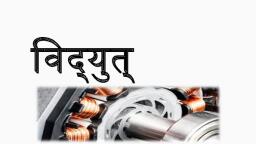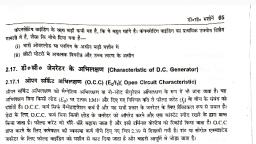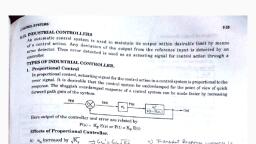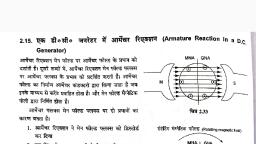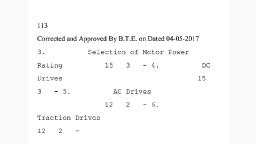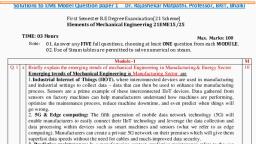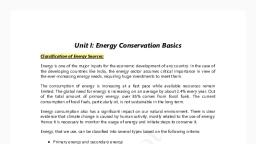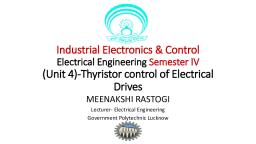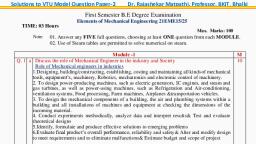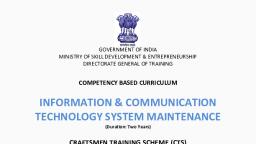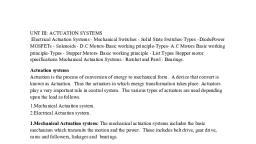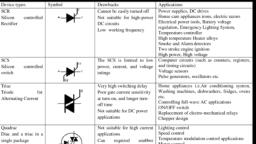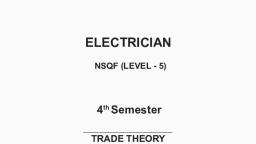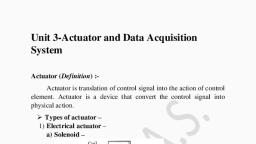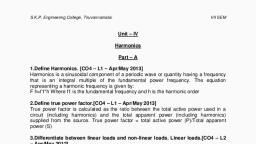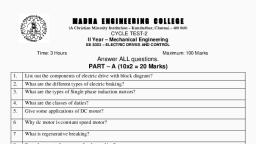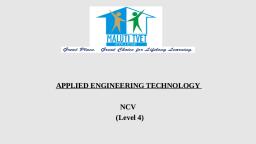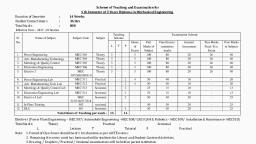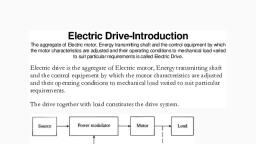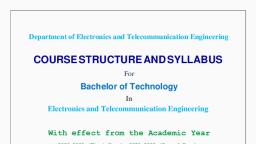Page 1 :
2, Electrical Drives, 2.1, , INTRODUCTION, , Nowadays, modern power electronics and drives are used in electrical as well as, mechanical industry. The power converter or power modulator circuits are used with, electrical motor drives, providing either DC or AC outputs, and working from either a, DC (battery) supply or from the conventional AC supply. Here we will highlight the most, important aspects which are common to all types of drive converters. Although there are, many different types of converters, all except very low-power ones are based on some, form of electronic switching. The need to adopt a switching strategy is emphasized in, the Wrist example, where the consequences are explored in some depth. We will see that, switching is essential in order to achieve high-efficiency power conversion, but that the, resulting waveforms are inevitably less than ideal from the point of view of the motor., The thyristor DC drive remains an important speed-controlled industrial drive,, especially where higher maintenance cost associated with the DC motor brushes (c.f., induction motor) is tolerable. The controlled (thyristor) rectifier provides a low-impedance, adjustable DC voltage for the motor armature, thereby providing speed control., , 2.1.1 Definitions of Electrical Drives, • An electrical drive can be defined as an electromechanical device for converting electrical, energy into mechanical energy to impart motion to different machines and mechanisms, for various kinds of process control., • An electrical drive is an industrial system which performs the conversion of electrical, energy into mechanical energy or vice versa for running and controling various processes., • An electrical drive is defined as a form of machine equipment designed to convert, electrical energy into mechanical energy and provide electrical control of the processes., The system employed for motion control is called an electrical drive., , 2.2 ELECTRICAL DRIVES AND THEIR BLOCK DIAGRAM, An electrical drive system has the following components (Fig. 2.1)., 1. Electrical machines and loads, 2. Motor, 3. Power modulator, 4. Sources, 5. Control unit, 6. Sensing unit
Page 2 :
Electrical Drives 9, , 2.2.5 Types of Power Modulators, In the electric drive system, the power modulators can be any one of the following:, 1. Controlled rectifiers (AC to DC converters), 2. Inverters (DC to AC converters), 3. AC voltage controllers (AC to AC converters), 4. DC choppers (DC to DC converters), 5. Cycloconverters (frequency conversion), , 2.2.6, , Electrical Sources, , Very low power drives are generally fed from single-phase sources. Rest of the drives are, powered from a three-phase source. Low and medium power motors are fed from a 400 V, supply. For higher ratings, motors may be rated at 3.3 kV, 6.6 kV, and 11 kV. Some drives, are powered from the battery., , 2.2.7 Control Unit, Control unit for a power modulator is provided in the control unit. It matches the motor, and power converter to meet the load requirements., , 2.2.8 Sensing Unit, 1. Speed sensing: Speed can be sensed by using a tachometer. Wind speed can be, sensed by anemometer similarly both speed and velocity can be measured by the, speedometer., 2. Torque sensing: Magnetoelastic torque sensor is used in-vehicles applications on, race cars, automobile, and aircraft., 3. Position sensing: Motion can be sensed through GPS, vibrometer, and rotary, encoder., 4. Current sensing and Voltage sensing from lines or from motor terminals., 5. Temperature sensing: Thermistor is a device which is used for temperature, measurement., , 2.3, , CLASSIFICATION OF ELECTRICAL DRIVES, , There are two types of electrical drives (Fig. 2.2)., (1) DC Drive: It is further classified into two types:, 1. Non-regenerative DC drives: Non-regenerative DC drives are the most, conventional type. In their most basic form, they are able to control motor speed, and torque in one direction., 2. Regenerative DC drives: Regenerative adjustable speed drives, also known as, four-quadrant drives, are capable of controlling not only the speed and direction, of motor rotation but also the direction of motor torque.
Page 3 :
Electrical Drives 11, , 2.5, , CHARACTERISTICS OF ELECTRIC DRIVES, , An electric drive provides electrical retarding and reduces service brake wear. It also, has many operational advantages. It includes the control of wheel slip and slide thus, reducing the tire wears. The system delivers a smoother ride for the operator. The electric, drive system enhancements include improved retarding grids, slip control algorithms,, the latest in diagnostic and troubleshooting software and silencers., , 2.6, , MICROPROCESSOR BASED ELECTRICAL DRIVES, , Microprocessor and microcontroller based electrical drives are DC motor drives, induction, motor drives and traction motor drives., , 2.6.1, , Microprocessor Based DC Motor Drives, , A microprocessor based control system can also be built where a phase controlled rectifier, supplies a DC motor., , Fig. 2.3, , Microprocessor based DC drives., , In Fig. 2.3 the armature and field winding of DC motor are supplied from three-phase, AC supply to AC-DC converter then it is fed to the armature and field winding. A techogenerator acts as a speed sensor, and it produces actual speed. Analog to Digital (A/D)
Page 4 :
Electrical Drives 13, , Fig. 2.4, , Fig. 2.5, , Microprocessor based AC drives., , Microprocessor based traction drives., , In general, the main task of the electrical drive is the motion control of mechanisms., An electrical drive is an automatic control system with a number of feedbacks where, different automatic control principles, such as error driven feedback control, model-based
Page 5 :
14, , Electric Drives, , control, logical binary control, or fuzzy logic control methods, are used. Depending on a, particular technical solution and selected control principle, different sensors for measuring, of currents, voltages, velocity, acceleration, torque, etc., in an electrical drive are used., Another information, like pressure signal for controlling pumps and compressors, air, humidity and/or temperature signal for controlling of fans, etc., is also necessary., , 2.7 APPLICATIONS OF ELECTRICAL DRIVES, Electric drives are used in boats,, 1. traction systems,, 2. lifts, cranes, electric car, etc., 3. They have flexible control characteristics. The steady state and dynamic, characteristics of electric drives can be shaped to satisfy the load requirements., 4. They are available in wide range of torque, speed, and power., 5. They can be started instantly and can immediately be fully loaded., 6. They can operate in all the four quadrants of the speed-torque plane., 7. They are adaptable to almost any operating conditions such as explosive and, radioactive environments., , 2.7.1 Advantages of Electric Drives, •, •, •, •, •, •, , Cost is too low as compared to another system of the drive., The system is more simple and clean., The control is very easy and smooth., Flexible in the layout., Facility for remote control., Transmission of power from one place to other can be done with the help of cables, instead of long shafts, etc., • Its maintenance cost is quite low., • It can be started at any time without delay., , Multiple-Choice Questions, 1. In electrical drives the component which is used to modulate power from source, to motor., (a) Control unit, (b) Power modulator, (c) Sensing unit, (d) Control command, 2. The power modulator which is used to convert fixed DC voltage to variable DC, voltage., (a) Controlled rectifier, (b) Un-controlled rectifier, (c) Chopper, (d) AC voltage controller
Page 6 :
16, , Electric Drives, , 15., 16., 17., 18., 19., 20., , Describe the working operation of microprocessor-based electrical drives., Draw and explain the block diagram of microprocessor based DC drives., Draw and explain the block diagram of microprocessor based AC drives., Describe the working of A/D and D/A converter in microprocessor based drives., Write a note on techo-generator., Draw the basic structure of microcontroller based traction drives.

